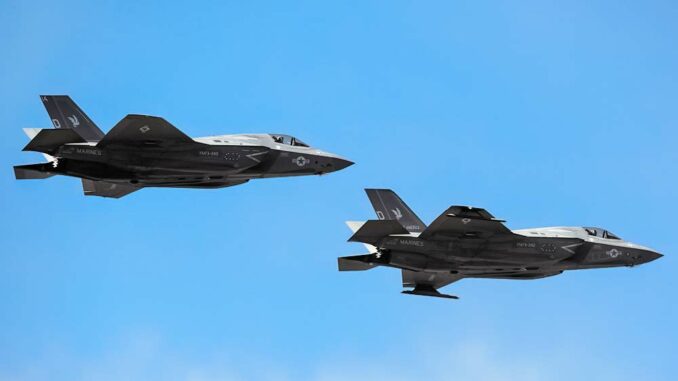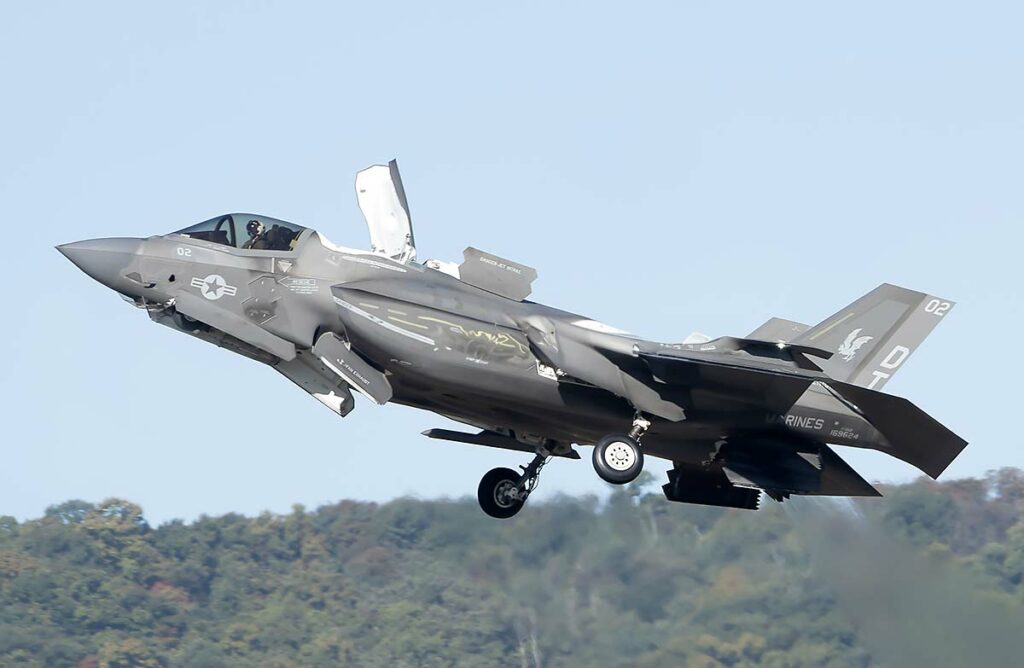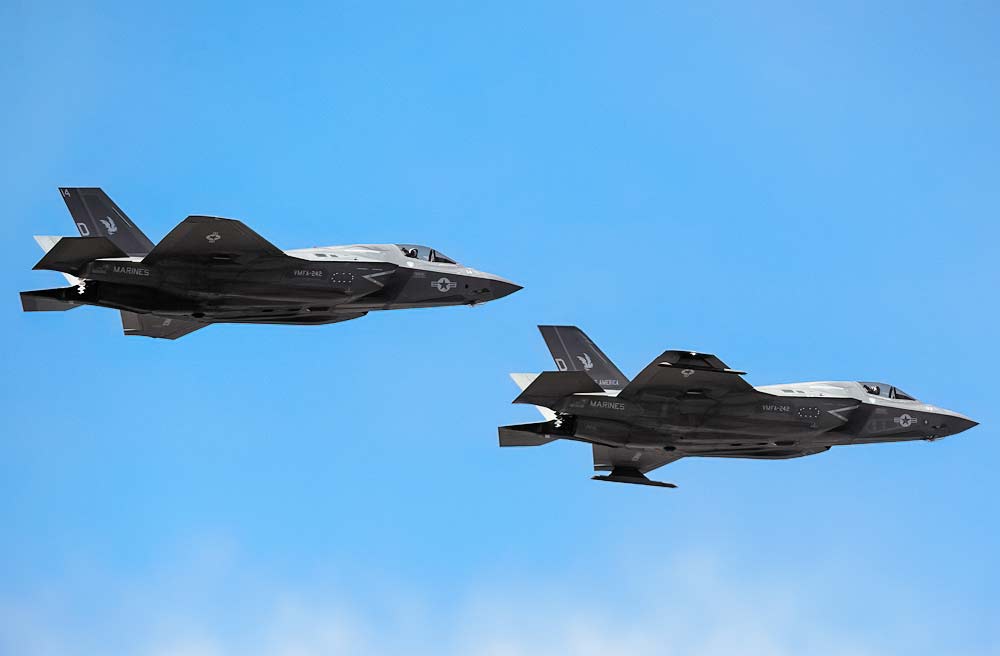
Uncover the global reach and strategic significance of F-35 Fighter Jet sales. Explore the details, budgets, and unique aspects of each country’s procurement.
The F-35 Lightning II, developed by Lockheed Martin, has become a hallmark of modern military aviation, marking its commercial success through global sales. This fifth-generation multirole stealth fighter, known for its advanced capabilities, has attracted significant attention from countries worldwide, each with unique defense needs and strategic considerations. Here, we delve into the specifics of the F-35’s global phenomenon, examining the purchases, budgets, and strategic implications for each country involved.

Purchase price of the F-35 fighter jet
The estimated purchase price of an F-35 fighter jet can vary depending on the model and the specific configuration and requirements of the purchasing country. However, as of my last update in April 2023, the approximate costs were as follows:
- F-35A (Conventional Takeoff and Landing variant): Around $78 million to $80 million per unit.
- F-35B (Short Takeoff and Vertical Landing variant): Approximately $104 million to $108 million per unit.
- F-35C (Carrier Variant): About $94 million to $98 million per unit.
These prices reflect the base cost of the aircraft and do not include additional expenses such as maintenance, training, spare parts, or specific customizations and upgrades that individual countries may request. It’s important to note that these prices can fluctuate due to various factors like inflation, changes in order quantities, and specific contract terms between Lockheed Martin and the purchasing country.
Purchase budget of the F-35 by country
United States; $194 Bn
- Purchases: 2,456 jets planned through 2044.
- Budget: Extensive, integrated into long-term defense spending. $194 Bn
- Reason for Success: Central to US tactical aviation; technological superiority.
- Unique Aspects: US models maintain the highest level of technological advancement.
United Kingdom: $14,6 Bn
- Purchases: 138 F-35B aircraft.
- Budget: Significant investment reflecting strategic partnership with the US. $14,6 Bn
- Reason for Success: Enhances UK’s naval and aerial capabilities.
- Unique Aspects: Tailored for aircraft carrier compatibility.
Italy: $7,9 Bn
- Purchases: 90 F-35s (60 F-35As, 30 F-35Bs).
- Budget: Aligned with modernization goals of Italian defense.
- Reason for Success: Diversification and enhancement of air power.
- Unique Aspects: Mix of conventional and short takeoff/vertical landing variants.
The Netherlands: $3,6 Bn
- Purchases: 46 F-35A aircraft.
- Budget: Strategic expenditure for air force modernization.
- Reason for Success: Upgrading from older generation aircraft.
- Unique Aspects: Customized for Dutch defense requirements.
Australia: $5,6 Bn
- Purchases: 72 F-35A aircraft, potential for more.
- Budget: Major defense investment.
- Reason for Success: Expanding air capabilities in the Pacific region.
- Unique Aspects: Focus on interoperability with allies.
Norway: $4,1 Bn
- Purchases: 52 F-35A jets.
- Budget: Significant part of national defense spending.
- Reason for Success: Replacing aging fleet with advanced technology.
- Unique Aspects: Adapted for Arctic conditions.
Israel: $3,9 Bn
- Purchases: 50 F-35s, plans for more.
- Budget: Partially financed by US aid.
- Reason for Success: Enhancing strategic air superiority in the Middle East.
- Unique Aspects: Custom modifications for Israeli defense needs.
Japan: $11,6 Bn
- Purchases: 147 F-35s (mix of A and B variants).
- Budget: Largest defense procurement in recent years.
- Reason for Success: Strengthening defense amidst regional tensions.
- Unique Aspects: Tailored for Japan’s defense strategy.
Belgium: $2,6 Bn
- Purchases: 34 F-35A aircraft.
- Budget: Key investment in air force modernization.
- Reason for Success: Replacement for aging F-16s.
- Unique Aspects: Enhanced interoperability with NATO forces.
Finland: $5 Bn
- Purchases: 64 F-35s.
- Budget: Major commitment reflecting a shift in defense strategy.
- Reason for Success: Countering regional security threats.
- Unique Aspects: Customized for Finnish defense requirements.
Germany: $2,3 Bn
- Purchases: 30 F-35A jets.
- Budget: Part of broader Future Combat Air System initiative.
- Reason for Success: Integrating advanced fighters into the air force.
- Unique Aspects: Focused on replacing aging Tornado jets.
Poland: $2,5 Bn
- Purchases: 32 F-35A aircraft.
- Budget: Significant defense modernization expense.
- Reason for Success: Enhancing NATO eastern flank capabilities.
- Unique Aspects: Adapted to Polish defense strategies.
South Korea: $5,2 Bn
- Purchases: 60 jets (40 F-35A and 20 F-35B).
- Budget: Approximately $5 billion.
- Reason for Success: Addressing regional security dynamics.
- Unique Aspects: Strengthening air power in response to regional threats.
Switzerland: $2,8 Bn
- Purchases: 36 F-35A jets.
- Budget: Essential part of air force renewal.
- Reason for Success: Upgrading to next-generation capabilities.
- Unique Aspects: Tailored for Swiss air defense needs.
Canada
- Purchases: Under consideration.
- Budget: To be determined as part of future fighter capability project.
- Reason for Success: Replacing aging CF-18 fleet.
- Unique Aspects: Decision influenced by NORAD commitments.
Singapore: $316 million
- Purchases: 4 F-35s, option for 8 more.
- Budget: Strategic investment in defense modernization.
- Reason for Success: Enhancing air superiority in Southeast Asia.
- Unique Aspects: Compact fleet for specific defense needs.
Czechia: $1,8 Bn
- Purchases: 24 F-35A jets.
- Budget: Approximately $6.5 billion.
- Reason for Success: Modernizing air force capabilities.
- Unique Aspects: Transition from Soviet-era aircraft.
These estimates are based on the assumption that most purchases are of the F-35A variant, except where specifically noted (like the UK and Italy, which include F-35B purchases). The actual budgets may vary based on the final mix of variants purchased and any specific customizations or additional support and maintenance services included in the contracts.
The global success of the F-35 Lightning II stems from a combination of its advanced technological capabilities and the strategic considerations of purchasing nations.

Factors influencing the purchase of the fighter jet
Advanced Capabilities of the F-35
- Stealth Technology: One of the F-35’s most notable features is its stealth technology. The aircraft’s design and materials allow it to evade detection by radar, making it highly effective in penetrating enemy defenses undetected. This stealth capability is crucial for modern air combat scenarios.
- Supersonic Speed: The F-35 is capable of reaching supersonic speeds, which means it can exceed the speed of sound. This speed enhances its ability to engage targets quickly and evade enemy aircraft.
- Extreme Agility: The aircraft is highly maneuverable, which is essential in dogfights and for avoiding enemy fire. Its agility also aids in executing complex air-to-ground missions.
- Sensor Fusion Technology: The F-35 is equipped with state-of-the-art sensors and avionics. Sensor fusion allows the jet to gather and process data from a wide array of sources, providing pilots with a comprehensive view of the battlefield. This integrated approach to information gathering significantly enhances situational awareness and decision-making in combat.
Political, Diplomatic, and Geostrategic Factors
- Purchases of the F-35 are often influenced by political and diplomatic relationships, particularly with the United States. Countries aligned or in partnership with the U.S. may choose the F-35 as part of broader defense collaborations.
- Geostrategic considerations also play a role. Nations facing specific regional threats or looking to bolster their defense capabilities in the context of local geopolitical dynamics may find the F-35 particularly appealing due to its advanced features.
Superior Performance and Adaptability
- The F-35’s design allows for a range of mission profiles, from air superiority and ground attack to electronic warfare and intelligence gathering. This adaptability makes it an attractive option for various military needs.
- Its performance in both air-to-air and air-to-ground combat scenarios, combined with advanced electronic warfare and intelligence capabilities, renders it a versatile and effective tool for modern militaries.
Technological Edge Maintained by the US
- Despite the widespread sale of the F-35, the United States retains a technological edge. The exported versions of the F-35 are generally similar to those used by the U.S. military but may lack some of the most sensitive or advanced technologies.
- Each country’s F-35s are customized to reflect their specific defense needs, aligned with the agreements made with the U.S. This customization ensures that while the F-35s are advanced, they are tailored to the strategic requirements of each nation.
Global Support System and Cost-Effectiveness
- All F-35s benefit from a common global support system. This unified approach to maintenance and support ensures operational readiness and helps reduce costs through shared resources and standardized processes.
- The economies of scale achieved through global sales and support also contribute to the overall cost-effectiveness of the F-35 program for participating nations.
Impact on Global Defense Partnerships
- The F-35 program represents not just a commercial triumph but also a significant advancement in global defense partnerships. Countries purchasing the F-35 often find themselves part of a broader network of nations with shared strategic interests, leading to increased cooperation and interoperability in defense matters.
- The F-35 serves as a linchpin in many nations’ defense strategies, enhancing collective security and fostering closer military ties between allies.
The F-35’s global success is attributed to its unparalleled technological capabilities, its adaptability to a wide range of mission profiles, the strategic considerations of purchasing nations, and the benefits of being part of a global support network. This combination of factors makes the F-35 not just a superior fighter jet but also a catalyst for international defense cooperation.
War Wings Daily is an independant magazine.